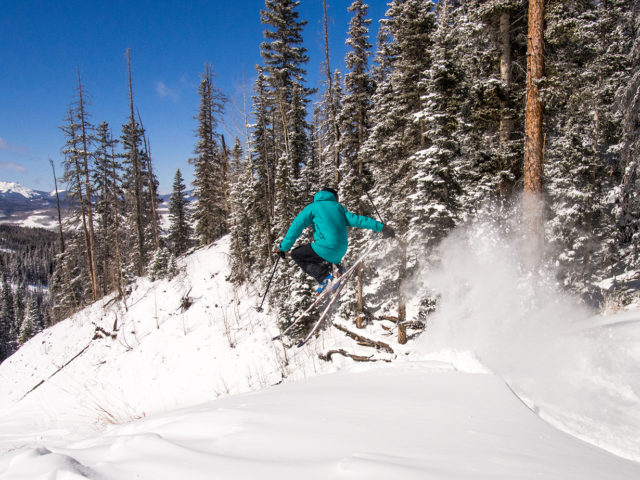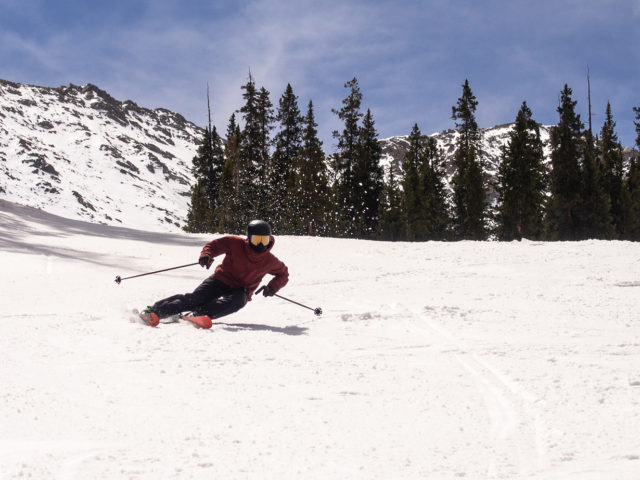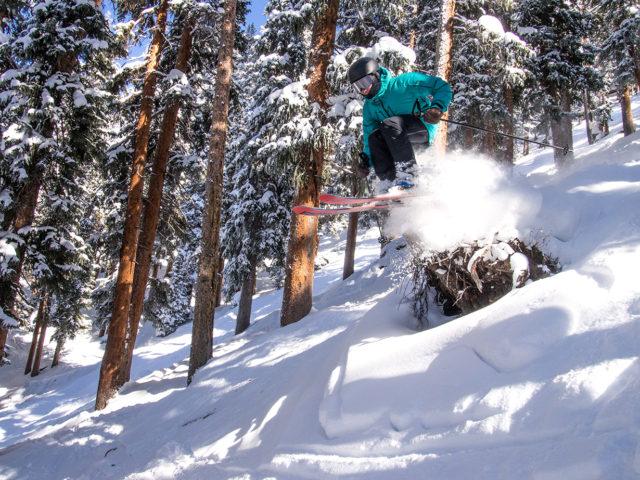This past season I spent several days on the revamped Prodigy 3.0, and my overall takeaway was that the ski is really fun, and that the updates Faction made to the Prodigy 3.0 make a lot of sense.
And, really, what follows here is basically two ski reviews in one, because I’m going to talk about how well the Prodigy works as a straight-up directional ski, and also how it performs as more of an all-mountain freestyle ski.
And since a big factor here is where you mount your bindings on the the Prodigy 3.0, I want to touch on that right away.
Mount Point / Preferred Stance
While its rocker profile and flex pattern are pretty symmetrical, the Prodigy 3.0 has a fairly traditional recommended mount point of -8 cm from center. And at that recommended line, this definitely feels like a directional ski, albeit a very playful one. On the line, the Prodigy 3.0 felt best when driving the shovels, and felt just a bit imbalanced in the air.
But as I tend to do with most skis — especially skis with more symmetrical rocker profiles and flex patterns — I ended up bumping the bindings forward of the recommended line, and I skied the Prodigy 3.0 at +1, +2, and +3 cm. The ski never felt particularly weird at any of those mount points, and I ended up settling on +2 (-6 cm from center) as my preferred spot.
At -6 cm from center, the Prodigy 3.0 checked all my boxes when it came to how it responded to different skiing styles. I could ski it with a pretty centered stance, but still had enough tip in front of my to pressure the shovels and keep them from getting knocked around when the snow got rough. At the same time, the Prodigy 3.0 felt more balanced in the air at -6 cm, and it also felt easier to pop off its tips and tails.
So directional skiers who are looking for a very playful ski should take a look at the Prodigy 3.0. And so should playful skiers looking for a more stable, freestyle-oriented all-mountain ski.
Soft Chop
I spent a good chunk of time skiing the Prodigy 3.0 in light, soft chop at Telluride, and heavier, slushy chop at A-Basin. In both types of snow, the ski felt pretty strong and composed for its weight, and how “freestyle-y” its rocker profile looks.
The Prodigy 3.0 certainly is not a Head Monster 108, or a Blizzard Cochise, or an ON3P Wrenegade 108. But it’s also not a super-soft jib noodle. Instead, the Prodigy 3.0 combines some of the stability and dampness of more directional skis with the playful feel of softer, more freestyle-oriented skis, and the result is a ski that sits on the more stable end of the spectrum compared to many other all-mountain freestyle skis.
I found that I could ski pretty aggressively through soft chop on the Prodigy 3.0, though I did have to stay a bit lighter on my feet and ski with a more active style than I did on some directional skis of similar weights. But compared to skis that are similarly playful (e.g., Sego Big Horn 106 & Faction Candide 3.0), the Prodigy 3.0 feels like it has very good suspension.
“But Luke, there are a ton of skis out there that you can ski hard in soft snow, so what’s so different about the Prodigy 3.0?”
Good question. The thing I really like about the Prodigy 3.0 is that it gives me options. Want to make big GS turns through some soft, off-piste snow? Go for it. Oh, there’s a pile of snow that looks like it really wants to be jumped off of? Send it (or at least, attempt to).
Playfulness
Speaking of jumping off stuff, the Prodigy 3.0 is a lot of fun if you spend your time seeking out kickers to hit, snow to slash, or friends to spray. I spent most of my time on the Prodigy 3.0 with the bindings at -6 cm, which I think added to its overall playful feel, but much of what I say below would still apply to the ski at its recommended line of -8 cm from center. Just expect the Prodigy 3.0 to feel a bit more directional, and a bit less balanced at -8 cm.
The Prodigy 3.0 isn’t the most playful ski in its class, but it’s certainly on the more playful end of the all-mountain spectrum. It has pretty deep tip and tail rocker lines and a good deal of tip and tail taper. And that shows on snow — this ski feels very loose, easy to maneuver, and I might even call it “surfy.” It isn’t as ridiculously easy to pivot as reverse-camber skis like the Moment Meridian, but I never found the Prodigy 3.0 to feel hooky or difficult to turn.
And then there are the Prodigy 3.0’s tips and tails. When Jonathan first showed me the flex pattern numbers for this ski, I honestly got a bit disheartened. The Prodigy 3.0’s tips and tails are pretty stout, and stiffer than pretty much any all-mountain freestyle ski I’ve been on.
But luckily for me — and anyone else that likes to pop off stuff — the Prodigy 3.0’s tips and tails are surprisingly snappy. They’re not super easy to bend initially (this is no Line Blend), but if I used the Prodigy 3.0’s rocker line to leverage the ski around the contact point, I could get a lot of pop out of it. This made the Prodigy 3.0 super fun when trying to nollie and ollie off little jumps.

I didn’t spend much time on the Prodigy 3.0 in the park, but for its width, I think it could do ok if you like to cruise through the park every once in a while. And for those skiers, I’d definitely recommend moving the bindings forward of the recommended line. But given its fairly stiff flex and heavier weight, I think the Prodigy 3.0 makes more sense for people who are seeking out stuff to jump off of all around the mountain, rather than just in the park.
In the air, the Prodigy 3.0 felt lighter than its weight would suggest. I think this is mostly due to its heavily tapered tips and tails. Skiing switch on the Prodigy 3.0 felt intuitive, and its tapered tips and generous rocker profile made it feel less likely to catch an edge when swapping between skiing forward and switch, as well as when my sorry attempts at spins and butters didn’t exactly go according to plan.
There are easier skis to butter, and there are looser skis that are easier to slash. But I think the Prodigy 3.0 strikes a very nice balance of stability and playfulness.
Groomers
There are a lot of super playful skis out there, but the Prodigy 3.0 is an all-mountain freestyle ski, so it’s supposed to handle the rest of the mountain too, not just jumps and side-hits.
On groomers, the Prodigy 3.0 feels predictable and pretty competent, but I wouldn’t call it excellent. Its generous rocker profile and tapered shape makes it a lot of fun to slash and slarve, but that does come at the cost of some groomer performance.

While the Prodigy 3.0 holds an edge pretty well, it’s far from being the most dynamic carver. Its tapered tips feel pretty vague on firm snow, and I found that I had to make more of an effort to tip over the Prodigy 3.0 to begin a turn compared to skis with less rocker and less tip taper. The Prodigy 3.0 definitely doesn’t feel like it wants to pull you into a turn.
The other thing I noticed was that, on groomers (and firm, off-piste snow), the Prodigy 3.0 felt a bit short. Its combo of lots of taper + lots of rocker leaves you with a fairly small platform to carve. So if you’re a directional skier just know that the Prodigy 3.0 will not provide as much effective edge as more traditionally shaped skis with less taper and rocker. But if you ski with a centered stance, I think the Prodigy 3.0’s rocker and taper will be a bit less noticeable since you will be primarily using the middle of the ski to carve, and the Prodigy 3.0 does offer good edgehold through the middle half of the ski.
Firm Crud
I didn’t get the Prodigy 3.0 on a ton of really firm, cruddy or inconsistent snow, but on the firm off-piste snow I did get it on, I definitely had less fun than I did on softer snow.
While the Prodigy 3.0 feels fairly damp, it does get knocked around more than a metal-laminate ski like the Nordica Enforcer 100, which has less rocker and taper. Compared to other skis in the all-mountain freestyle class, I’d say the Prodigy 3.0 still sits on the more stable end, but it doesn’t feel extremely confidence inspiring in crud.

And I think most of this comes down to the Prodigy 3.0’s taper and rocker profile. I find that, in really nasty conditions, it helps to have more effective edge so that I can engage more of the ski and help keep the ski tracking in the right direction. When more of the ski is already in contact with the snow, it’s easier to keep it there. But when the tips and tails are raised off the snow, it’s more difficult to to keep them from getting knocked off track. This is just a tradeoff you deal with when it comes to skis like the Prodigy 3.0 that feature a lot of tip and tail rocker.
Moguls
While I didn’t love the Prodigy 3.0 on groomers or in really firm crud, I did really like it in bumps. Its combination of (1) deep rocker lines, (2) lots of taper, and (3) a stout-but-not-unbendable flex pattern made it a lot of fun in moguls.
I’m not typically one to try to zipperline or aggressively mash my way through bumps. Instead, I prefer to slide, pivot, and find the occasional mogul that has enough room to jump off of and skip troughs. And for my style of bump skiing, the Prodigy 3.0 works quite well.
That looseness that I mentioned earlier made the Prodigy 3.0 quite easy to pivot in moguls, and its tips and tails felt plenty supportive when I got knocked off balance. The Prodigy 3.0 felt best in bumps when I skied with a pretty centered stance, rather than when driving the shovels really hard (this was true at all mount points).
I think beginner and low-intermediate skiers might find the tips and tails of the Prodigy 3.0 to feel a bit too stiff in bumps, but I don’t think advanced skiers will have any trouble with how stiff they are. If anything, I think advanced and expert skiers who ski bumps with an aggressive, forward stance might find the Prodigy 3.0 to feel a bit too easy. This ski has a lot of tip and tail rocker, so while it’s actually pretty stiff, it won’t provide the instant support of a similarly stiff ski with less rocker.
Who’s It For?
Since it responds well to both a forward stance (when skied on the recommended line) and a more centered stance (with the bindings pushed a few cm forward), I think a lot of people could get along well with the Prodigy 3.0.
Directional skiers interested in a very playful ski that they can still drive and that doesn’t fall apart in soft chop, the Prodigy 3.0 could be a good option. I think the main factor to consider if you’re a directional skier is how much you care about having a lot of effective edge. If you’re used to skis with more moderate rocker profiles and / or less tip and tail taper, you might initially find the Prodigy 3.0 to feel a bit short, particularly on firm snow.
More playful skiers who are looking for a ski that offers a bit more stability than many skis in the all-mountain freestyle category, but that’s still poppy and easy to slash, the Prodigy 3.0 also makes a lot of sense. While the Prodigy 3.0 has a fairly traditional recommended mount point, it still feels very much like a freestyle ski (especially with the bindings moved forward of that line).
Bottom Line
I think Faction did an excellent job with the updated Prodigy 3.0. It’s easy to slash, gives you plenty of pop (far more than the previous iteration of this ski) when you want to jump off something, and still provides better stability than many skis in the all-mountain freestyle category. And since it feels pretty good both at the recommended line and with the bindings pushed closer to center, I think it could work for both directional and more freestyle-oriented skiers. The Prodigy 3.0 is a ski that gives you plenty of options — whether you want to slarve and surf your way around the mountain, cruise groomers, or blast off every patch of snow in sight.
Deep Dive Comparisons: Faction Prodigy 3.0
Become a Blister Member or Deep Dive subscriber and check out our Deep Dive of the Prodigy 3.0 to see how it stacks up against the Faction Candide 3.0, Atomic Bent Chetler 100, Blizzard Rustler 10, ON3P Kartel 108, Moment Meridian 107, Line Sick Day 104, Fischer Ranger 102 FR, and more…
NEXT: Rocker Profile Pics

What about powder performance?
Hi, very nice review. I will try to demo the Prodigy this winter. One question: I noted that you do mention other skis in comparison (in this Review and others) like the SD 104, Rustler 10, Ranger 102 etc. However, no mention of the Soul 7. Any reason for that? Is the Soul 7 Not as good or interesting?
Thanks and keep up the good work!
Hi Luke,
Nice review. Could you please answer following question? I tried CT 2.0 in park – and really like swing weight, flex and rail performance. However on all mountain side it seems that I didn’t like its true twin shape in really soft snow, bumps and powder I felt like it was harder to ski than on skis with directional twin shape (I mean when tip is wider than heel). like heel constantly hooked on snow. I wonder how prodigy 3.0 with -2.5…-3 mount would compare to CT 2.0 or CT3.0 as 1 travel ski to learn stuff in park and ski all mountain. your flex indication shows that they are really stiff. With ct 2.0 butter become really easy. Also I’m 177 cm and 60 kg. Would it still be easy to butter these skis (prodigy 3.0) in 183?